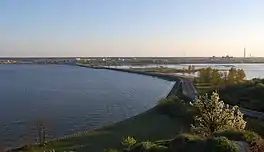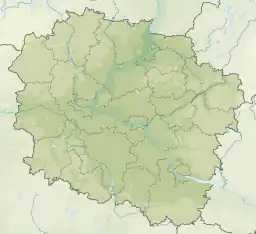Włocławek Reservoir
Włocławek Reservoir[1] (Polish: Zbiornik Włocławski) is a water body in the Middle Vistula flow that appeared in 1970 after building of the dam in Włocławek. The length of the reservoir is 58 km from Włocławek to Płock, average width is 1.2 km. It is the biggest reservoir in Poland.
| Włocławek Reservoir | |
|---|---|
 | |
 Włocławek Reservoir | |
| Location | Kuyavian-Pomeranian Voivodeship |
| Coordinates | 52°37′04″N 19°24′28″E |
| Type | Hydroelectricity Reservoir |
| Primary inflows | Vistula |
| Primary outflows | Vistula |
| Basin countries | Poland |
Due to the significant amount of organic matter in the tank (approx. 11.5% of the dry weight of sediment), it emits approx. 400 mg of methane per area of 1 m2 (which is approx. 27% of the total amount of gases emitted from the sediment of average 3114 ml m−2 d−1). For this reason, is considered an important source of greenhouse gases emission.[2]
Functions
The tank has three basic functions:
- Retention - during floods, water on the Vistula River reservoir retains a large part of the floodwaters;
- Energy - on the dam is Wloclawek hydroelectric power plant;
- Tourism - Lake Wloclawski developed following tourist centers: Zarzeczewo, Wistka Kings, Soczewka, Murzynowo.
Flood protection
Wloclawek reservoir tank is essentially instantaneous. From approx. 2004. In the event of high water levels acts as a storage reservoir.[3]
Flood 2010
On 17 May at the dam in Wloclawek thrown water (3,000 m³/s), preparing for the arrival of the flood wave. 22 May inflow was 6,000 m³/s, a snapshot already amounted to 5700 m³/s.[4] During the climax assumed dump 6,300 m³/s.[5] May 23, at 14 the culmination wave reached Wloclawek, but the water level was lower than expected initially, due to the rupture of a dam in the town of Świniary under Plock iem.[6][7]
Flood 2014
During the flood Vistula May 22, 2014 r. To Włocławski Reservoir affect 4900 m³/s, the discharge was at that time 4300 m³/s. As a result, they managed to flatten the wave of flood and reduce the risk of flooding in the lower section of the Vistula.[3]
References
- "List of names of reservoirs" (PDF). Archived from the original (PDF) on 2019-03-25. Retrieved 2010-12-17.
- Adriana Trojanowska, Marta Kurasiewicz, Luke Mucor, Mariusz Orion Jędrysek (2009). "Emission of methane from sediments of selected Polish dam reservoirs" (PDF). Teka Commission for the Protection and Environmental - OL PAN. 6: 368–373. Archived from the original (PDF) on 2012-01-03.
{{cite journal}}: CS1 maint: multiple names: authors list (link) - "dam in Wloclawek flattens wave. Every second of the dam flows 4,900 cubic meters. Water". Retrieved 2015-04-20.
- Dam in Wloclawek May 22, 2010.
- "Dam in Wloclawek is working at full power. Withstand". Retrieved 2015-04-20.
- In Wloclawek Wisła not raised.
- shaft broken in Świniary, 4 thousand. people to evacuate.